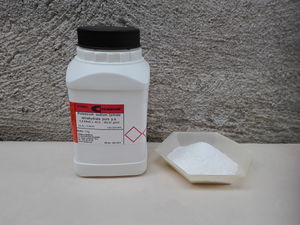Potassium sodium tartrate
 Potassium sodium tartrate aka Rochelle salt
| |
| Names | |
|---|---|
| IUPAC name
Sodium potassium L(+)-tartrate tetrahydrate
| |
| Other names
E337
Rochelle salt Seignette salt | |
| Properties | |
| KNaC4H4O6 (anhydrous) KNaC4H4O6·4H2O (tetrahydrate) | |
| Molar mass | 210.16 g/mol (anhydrous) 282.1 g/mol (tetrahydrate) |
| Appearance | Large colorless monoclinic needles |
| Odor | Odorless |
| Density | 1.79 g/cm3 |
| Melting point | 75 °C (167 °F; 348 K) |
| Boiling point | 220 °C (428 °F; 493 K) (decomposes) |
| 26 g/100 ml (0 °C) 47.4 g/100 ml (6 °C) 66 g/100 ml (26 °C) | |
| Solubility | Insoluble in acetone, ethanol |
| Vapor pressure | ~0 mmHg |
| Hazards | |
| Safety data sheet | Sigma-Aldrich (tetrahydrate) |
| Related compounds | |
| Related compounds
|
Tartaric acid Potassium antimony tartrate |
| Except where otherwise noted, data are given for materials in their standard state (at 25 °C [77 °F], 100 kPa). | |
| Infobox references | |
Potassium sodium tartrate (tetrahydrate), more commonly known as Rochelle salt, is a double salt of tartaric acid first prepared (around 1675) by an apothecary, Pierre Seignette, of La Rochelle, France.
Contents
[hide]Properties
Chemical
Addition of a strong acid, like hydrochloric acid, will give tartaric acid.
Physical
Potassium sodium tartrate is a white crystalline solid, soluble in water.
Availability
Rochelle's salt can be bought from chemical suppliers, in bulk, and it's fairly cheap.
Potassium sodium tartrate is readily available on eBay and Amazon.
Preparation
Can be prepared by neutralizing tartaric acid with sodium and potassium carbonates, bicarbonates or hydroxides.
A much simpler and straightforward route involves neutralization of potassium bitartrate with sodium hydroxide.
Projects
- Make Biuret reagent
- Make Fehling's solution
- Demonstration of piezoelectricity
- Make "crystal" microphones
- Alkaline buffer
- Laxative
Handling
Safety
Potassium sodium tartrate has low toxicity, though the dry salt can be irritating to skin, mouth, nose and eyes.
Ingestion of large amounts of Rochelle salt will lead to bloating and diarrhea.
Storage
Potassium sodium tartrate is very deliquescent and should be stored in a sealed container.
Disposal
Dissolve in large excess of water and put down drain.